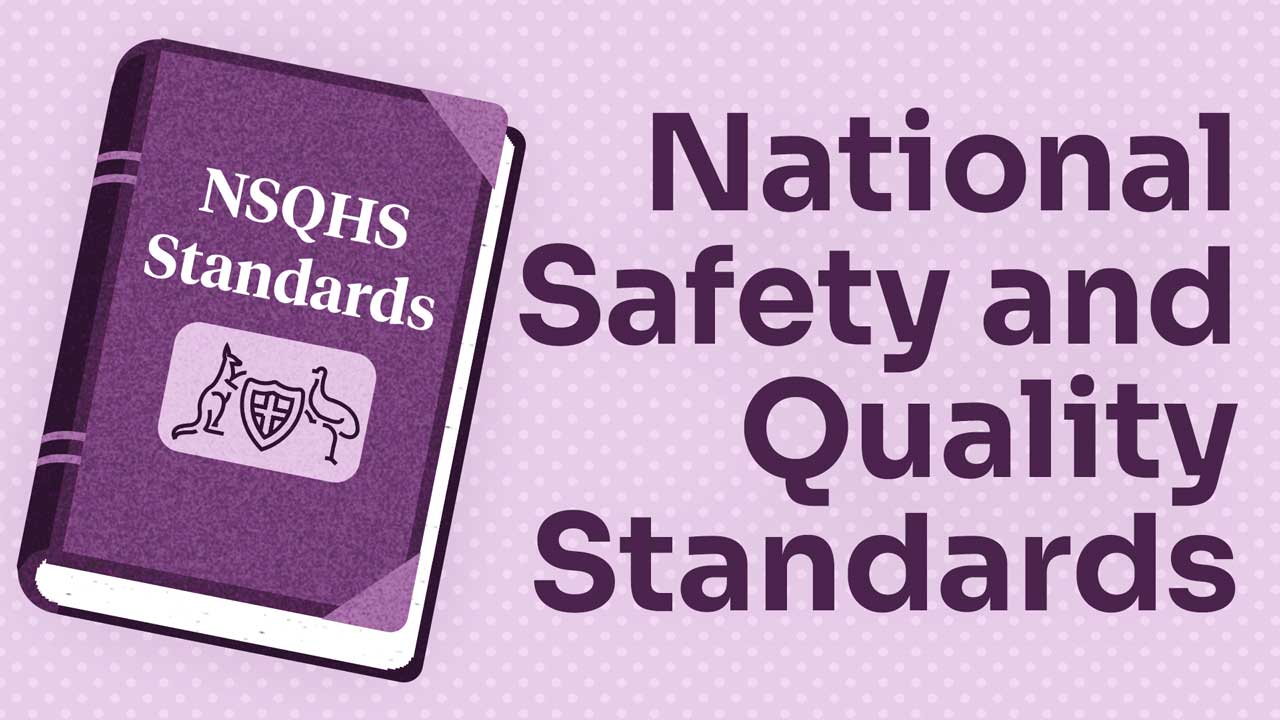This article explains the second edition of the National Safety and Quality Health Service (NSQHS) Standards, which were released in November 2017 and updated in May 2021.
What?
The National Safety and Quality Health Service (NSQHS) Standards.
Who?
The NSQHS Standards were developed by the Australian Commission on Safety and Quality in Health Care in collaboration with the Australian Government, Australian states and territories, the private sector, clinical experts, patients and carers.
Why?
The NSQHS Standards aim to ‘protect the public from harm and to improve the quality of health service provision’.
How?
The NSQHS Standards act as quality indicators to ensure the safety and quality of Australian healthcare services (ACSQHC 2021).
What are the Eight NSQHS Standards?
This article will provide a brief outline of each Standard.
1. Clinical Governance

‘Leaders of a health service organisation have a responsibility to the community for continuous improvement of the safety and quality of their services, and ensuring that they are person centred, safe and effective.’
Purpose: To ensure that healthcare organisations establish a clinical governance framework so systems are in place to provide patients with safe, high-quality care.
What Does This Mean?
Essentially, clinical governance is in place so the community can be certain that systems exist to provide safe and effective healthcare and that these systems are not set in stone but continuously improved upon by the organisation.
This Standard contains the following criteria:
- Governance, leadership and culture
- Patient safety and quality systems
- Clinical performance and effectiveness
- Safe environment for the delivery of care.
(ACSQHC 2021)
2. Partnering with Consumers

‘Leaders of a health service organisation develop, implement and maintain systems to partner with consumers. These partnerships relate to the planning, design, delivery, measurement and evaluation of care. The workforce uses these systems to partner with consumers.’
Purpose: To emphasise the importance of involving patients as partners, rather than simply consumers, in every step of the healthcare services they receive. Patients are given the opportunity to participate actively in their care, which benefits both patients and providers.
What Does This Mean?
This Standard reinforces the importance of partnership between care providers and consumers. Dignity, respect, information sharing and collaboration are key to cementing meaningful partnerships.
Partnerships are needed at three main levels:
- With the individual (between healthcare staff and patients)
- With the service, department or program of care
- With the health service (consumers are involved in all aspects of care provision).
This Standard contains the following criteria:
- Clinical governance and quality improvement systems to support partnering with consumers
- Partnering with patients in their own care
- Health literacy
- Partnering with consumers in organisational design and governance.
(ACSQHC 2021)
3. Preventing and Controlling Infections

‘Leaders of a health service organisation develop, implement and monitor systems to prevent, manage and control infections and antimicrobial resistance; reduce harm for patients, consumers and members of the workforce; and achieve good health outcomes for patients. The workforce uses these systems to minimise and manage risks to patients and consumers.’
Purpose: To reduce the risk of patients and staff contracting preventable infections; manage infections effectively; restrict the development of antimicrobial resistance through the correct prescribing and use of antimicrobials; and encourage the appropriate and sustainable use of infection prevention resources.
What Does This Mean?
This Standard recognises that within Australian healthcare settings, there is a risk of infectious agents spreading due to patients being treated in close quarters. It also recognises that healthcare-associated infections (HAIs) make up a large percentage of all patient complications (NHMRC 2024).
The updated version of this Standard also acknowledges the challenges posed by novel infections that require rapid responses, such as COVID-19.
This Standard contains the following criteria:
- Clinical governance and quality improvement to prevent and control infections and support antimicrobial stewardship and sustainable use of infection prevention and control resources
- Infection prevention and control systems
- Reprocessing of reusable medical devices
- Antimicrobial stewardship.
(ACSQHC 2021)
4. Medication Safety

‘Leaders of a health service organisation describe, implement and monitor systems to reduce the occurrence of medication incidents and improve the safety and quality of medication use. The workforce uses these systems.’
Purpose: To ensure that clinicians work safely with appropriate medicines and monitor medicine use. Additionally, to ensure that consumers are informed about medicines and have an understanding of their own medicine needs and associated risks.
What Does This Mean?
This Standard focuses on medication, the most common treatment used in healthcare. While medications, when used appropriately, can positively influence a patient's health, they also have the potential to cause considerable harm. Up to half of medicine-related incidents are potentially preventable.
Standard 4 aims to reinforce the correct use of medications, as medication errors create negative health outcomes for consumers and increase healthcare costs. It asserts that medication safety can be improved through standardising and systemising processes.
This Standard contains the following criteria:
- Clinical governance and quality improvement to support medication management
- Documentation of patient information
- Continuity of medication management
- Medication management processes.
(ACSQHC 2021)
5. Comprehensive Care

‘Leaders of a health service organisation set up and maintain systems and processes to support clinicians to deliver comprehensive care. They also set up and maintain systems to prevent and manage specific risks of harm to patients during the delivery of healthcare. The workforce uses the systems to deliver comprehensive care and manage risk.’
Purpose: To ensure that patients receive comprehensive healthcare that meets their goals and needs. This care should also consider the impact that patients’ health issues will have on their life and wellbeing. This Standard requires targeted strategies to be put in place to ensure that risks to patients during healthcare are prevented and managed.
What Does This Mean?
This Standard identifies gaps in safety and quality within Australian healthcare due to inadequate care for specific conditions, in specific settings or for certain populations. It aims to bridge those gaps with comprehensive care.
Specific risks of patient harm identified by this Standard include:
- Pressure injuries
- Falls
- Nutrition and hydration
- Delirium and cognitive impairment
- Self-harm and suicide
- Aggression and violence
- Restrictive practices (seclusion and restraint).
Care must be continuous and collaborative, based on a partnership ideology, communicated effectively and carried out as a team. This approach should be flexible to account for local implementation.
This Standard contains the following criteria:
- Clinical governance and quality improvement to support comprehensive care
- Developing a comprehensive care plan
- Delivering comprehensive care
- Minimising patient harm.
(ACSQHC 2021)
6. Communicating for Safety

‘Leaders of a health service organisation set up and maintain systems and processes to support effective communication with patients, carers and families; between multidisciplinary teams and clinicians; and across health service organisations. The workforce uses these systems to effectively communicate to ensure safety.’
Purpose: To ensure that communication and documentation is timely, purpose-driven and effective, and that it enables continuous, coordinated and safe patient care.
What Does This Mean?
This Standard emphasises that the success of continuous, coordinated and safe care hinges upon communication. It highlights the need for effective communication in high-risk scenarios such as clinical handover, and any situation in which a patient’s identity is unclear.
Health service organisations must have systems and processes in place to encourage effective communication and documentation in these high-risk scenarios.
This Standard contains the following criteria:
- Clinical governance and quality improvement to support effective communication
- Correct identification and procedure matching
- Communication at clinical handover
- Communication of critical information
- Documentation of information.
(ACSQHC 2021)
7. Blood Management

‘Leaders of a health service organisation describe, implement and monitor systems to ensure the safe, appropriate, efficient and effective care of patients’ own blood, as well as other blood and blood products. The workforce uses the blood product safety systems.’
Purpose: To ensure that a patient’s blood is optimised, conserved, and safely and properly managed. It also ensures that any blood and blood products provided to patients are safe and appropriate.
What Does This Mean?
This Standard recognises the role that blood and blood products play in improving patients' health but flags the potential risks associated with blood and other biological materials.
It recommends specific actions to reduce these risks, such as screening blood donors and blood and carefully weighing the risks of treatment options before transfusing. An organisation is also required to have safe and efficient blood management systems in place.
This Standard contains the following criteria:
- Clinical governance and quality improvement to support blood management
- Prescribing and clinical use of blood and blood products
- Managing the availability and safety of blood and blood products.
(ACSQHC 2021)
8. Organisational Governance

‘Leaders of a health service organisation set up and maintain systems for recognising and responding to acute deterioration. The workforce uses the recognition and response systems.’
Purpose: To ensure that acute deterioration in a patient’s physical, mental or cognitive condition is recognised immediately, and appropriate action is taken.
What Does This Mean?
This Standard aims to curb the prevalence of unexpected death and cardiac arrest that could have been avoided had physiological and clinical differences been observed at an earlier stage. It recognises that the factors contributing to the failure to see early signs happen at both an organisational and workforce level.
This Standard requires an organisation to design systems to detect and respond to deterioration early. These systems should be applied across the entire healthcare facility.
This Standard contains the following criteria:
- Clinical governance and quality improvement to support recognition and response systems
- Detecting and recognising acute deterioration, and escalating care
- Responding to acute deterioration.
(ACSQHC 2021)
Test Your Knowledge
Question 1 of 3
What does Standard 1: Clinical Governance focus on?
Topics
References
- Australian Commission on Safety and Quality in Health Care 2021, National Safety and Quality Health Service Standards, 2nd edn, Australian Government, viewed 8 October 2024, https://www.safetyandquality.gov.au/publications-and-resources/resource-library/national-safety-and-quality-health-service-standards-second-edition
- National Health and Medical Research Council 2024, Australian Guidelines for the Prevention and Control of Infection in Healthcare, Australian Government, viewed 8 October 2024, https://www.safetyandquality.gov.au/publications-and-resources/resource-library/national-safety-and-quality-health-service-standards-second-edition
 New
New 
